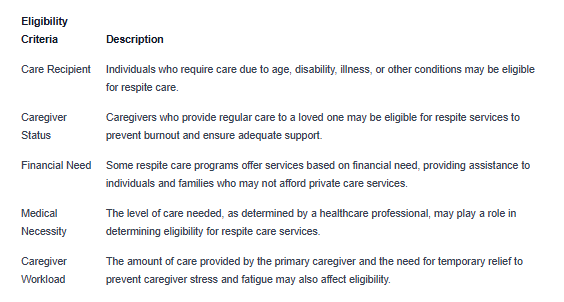How Many Hours Of Respite Care Are You Allowed?
March 5, 2025
Unlock the secret to respite care hours entitlement! Know your rights and maximize your support.


Understanding Respite Care
When it comes to caring for individuals in need, respite care plays a vital role in providing temporary relief to primary caregivers. Let's delve into what respite care entails and why it holds significant importance in the realm of caregiving.

What is Respite Care?
Respite care refers to the temporary care provided to individuals who require assistance with daily activities due to age, disability, illness, or cognitive impairment. This type of care is designed to offer relief to primary caregivers by ensuring that their loved ones are well-cared for in their absence. Respite care can be provided in various settings, including at home, in a community center, or in a residential facility, depending on the needs of the care recipient and caregiver.
Importance of Respite Care
The importance of respite care cannot be overstated, as it offers numerous benefits to both the care recipient and the caregiver. For the care recipient, respite care provides an opportunity to socialize, engage in activities, and receive specialized care that may not be available at home. It also helps prevent isolation and promotes overall well-being.
On the other hand, respite care allows primary caregivers to take a much-needed break from their caregiving responsibilities, reducing stress and preventing burnout. By having dedicated respite care hours, caregivers can attend to their own needs, rest, and recharge, thereby enhancing their ability to provide quality care in the long run.
In essence, respite care serves as a lifeline for caregivers, enabling them to strike a balance between their caregiving duties and personal well-being. Understanding the essence of respite care is crucial for both caregivers and care recipients to fully benefit from the support and relief it offers.
Accessing Respite Care Hours

When it comes to accessing respite care, the number of hours you are eligible for can vary based on several factors and is determined through an assessment process.
Factors Affecting Respite Care Hours
The number of respite care hours allocated to an individual is influenced by a range of factors. These factors may include:
- Care Needs: The level of care required by the individual can impact the number of respite care hours they are eligible for.
- Family Situation: The caregiver's availability and support network can play a role in determining the amount of respite care hours provided.
- Medical Condition: The individual's medical condition and specific care requirements are taken into consideration when calculating respite care hours.
- Financial Resources: Financial considerations may affect the amount of respite care hours available to an individual.
Understanding these factors is essential in determining the appropriate level of respite care support needed to meet the individual's care requirements.
Assessment Process for Determining Hours
The assessment process for determining respite care hours typically involves:
- Initial Assessment: A healthcare professional evaluates the individual's care needs and discusses the potential benefits of respite care.
- Care Plan Development: Based on the assessment, a personalized care plan is developed, outlining the specific care services required.
- Hour Allocation: The number of respite care hours allocated is determined based on the individual's care plan, taking into account factors such as care needs, medical condition, and family support.
During the assessment process, open communication between the individual, caregiver, and healthcare provider is key to ensuring that the allocated respite care hours meet the individual's needs effectively.
By understanding the factors that influence respite care hours and the assessment process involved in determining these hours, individuals can navigate the respite care system more effectively and access the appropriate level of care and support they require.
Types of Respite Care
When exploring respite care options, individuals have the choice between in-home respite care and out-of-home respite care, each offering unique benefits tailored to the needs of both the care recipient and the caregiver.
In-Home Respite Care
In-home respite care provides support and assistance within the comfort of the care recipient's own residence. This type of respite care allows the caregiver to take a break while ensuring that the care recipient receives personalized care in a familiar environment.

In-home respite care is particularly beneficial for individuals who prefer to receive care in their own home or for those with mobility or transportation constraints that make accessing out-of-home care challenging.
Out-of-Home Respite Care
Out-of-home respite care entails the care recipient temporarily residing in a care facility or community center outside of their home environment. This type of respite care offers a change of scenery and access to additional resources and social interactions.

Out-of-home respite care is suitable for individuals who may benefit from socializing with others, require round-the-clock supervision, or seek a change of environment to enhance their well-being. Caregivers can also benefit from this type of respite care by having dedicated time for self-care and rejuvenation.
Understanding the differences between in-home and out-of-home respite care can help individuals make informed decisions based on their specific needs and preferences. By exploring these options, caregivers and care recipients can find the most suitable respite care arrangement that promotes overall well-being for both parties.
Determining Your Eligibility
When considering respite care, it is essential to understand the eligibility criteria and the application process to access these much-needed services.
Eligibility Criteria for Respite Care
The eligibility criteria for respite care may vary depending on the specific program or service provider. However, there are some common factors that are typically taken into consideration when determining eligibility for respite care services:

Understanding these eligibility criteria can help individuals and families assess whether they qualify for respite care services and what level of support they may be entitled to receive.
How to Apply for Respite Care
The application process for respite care typically involves several steps to ensure that individuals receive the appropriate level of care and support. While the process may vary depending on the specific program or provider, here are some general steps involved in applying for respite care:
- Assessment: The first step in applying for respite care is often an assessment of the care recipient's needs and the caregiver's situation. This assessment helps determine the level of care required and the frequency of respite services needed.
- Documentation: Once the assessment is complete, applicants may be required to provide documentation to support their eligibility for respite care. This may include medical records, caregiver status verification, and financial information.
- Application Submission: After gathering the necessary documentation, individuals can submit their application for respite care services to the designated agency or organization. It is essential to follow the specific instructions provided by the service provider to ensure a smooth application process.
- Review and Approval: The submitted application will be reviewed by the relevant authorities to determine eligibility for respite care services. Once the application is approved, individuals will be notified of the respite care hours they are entitled to access.
By understanding the eligibility criteria and following the application process, individuals can navigate the system effectively to access the respite care hours they need to support both the care recipient and the caregiver.
Utilizing Respite Care Hours
Once you have been approved for respite care and allocated a specific number of hours, it's important to effectively plan and make the most of these hours to ensure both the caregiver and care recipient benefit fully.
Planning and Scheduling Respite Care
Creating a structured plan for respite care hours is essential to ensure smooth and efficient coverage. Consider the following steps when planning and scheduling respite care:
- Assess Needs: Evaluate the specific care needs of the individual requiring assistance to determine the type and frequency of respite care required.
- Identify Preferences: Take into account the preferences of both the caregiver and care recipient when scheduling respite care. Consider factors such as time of day, duration of care, and preferred activities.
- Communication: Maintain open communication with respite care providers to coordinate schedules, address any concerns, and ensure the continuity of care.
- Emergency Plan: Have a contingency plan in place in case of unexpected circumstances that may affect the delivery of respite care.
By planning ahead and clearly outlining the schedule for respite care, both parties can have peace of mind and ensure a successful care experience.
Making the Most of Your Respite Care Hours
To maximize the benefit of respite care hours, consider the following strategies:
- Self-Care: Use respite care hours to prioritize self-care and personal well-being. Take time to relax, engage in activities you enjoy, or simply rest and recharge.
- Support Network: Consider involving other family members, friends, or support services during respite care hours to provide additional assistance and companionship.
- Goal Setting: Define specific goals or activities to accomplish during respite care hours, whether it's pursuing hobbies, attending appointments, or simply enjoying quality time with loved ones.
- Feedback and Evaluation: Provide feedback to respite care providers on the effectiveness of the care received and any adjustments that may be needed for future sessions.
By making the most of the allocated respite care hours through effective planning, communication, and utilization of support resources, caregivers and care recipients can experience the full benefits of this valuable service.
Advocating for Your Rights
When it comes to accessing respite care, it's essential to advocate for your rights and understand the entitlements available to you. By being informed about your rights and seeking support and assistance when needed, you can ensure that you receive the appropriate level of care and support.
Knowing Your Rights and Entitlements
Understanding your rights and entitlements regarding respite care is crucial for ensuring that you receive the necessary services. The number of hours of respite care you are allowed can vary based on several factors, including eligibility criteria, assessment results, and the specific needs of the individual requiring care.

It's important to familiarize yourself with the eligibility criteria set forth by relevant authorities and understand the process for determining the number of respite care hours you are entitled to receive. By knowing your rights, you can advocate for the appropriate level of care and support for yourself or your loved one.
Seeking Support and Assistance
Advocating for your rights in the realm of respite care may require seeking support and assistance from various sources. Whether it's consulting with healthcare professionals, reaching out to advocacy organizations, or engaging with social services, obtaining guidance and information can empower you to navigate the complexities of accessing respite care effectively.
Additionally, connecting with support groups or caregiver networks can provide valuable insights and experiences from individuals who have been through similar situations. These platforms can offer emotional support, practical advice, and resources that can aid in advocating for your rights and optimizing the respite care hours available to you.
Remember that advocating for your rights in the context of respite care is an ongoing process. Stay informed, communicate your needs effectively, and seek assistance when necessary to ensure that you and your family receive the care and support you are entitled to. By being proactive and empowered, you can make informed decisions and access the respite care services that best meet your requirements.
Sources
https://alwaysbestcare.com/resources/how-many-hours-respite-care-are-you
https://seniorservicesofamerica.com/blog/how-many-hours-of-respite-care-are-you-allowed/
https://www.webmd.com/cancer/what-is-respite-care



























































.jpeg)











































































































































































































.avif)























































.jpeg)
































































.jpeg)














.jpg)









































.jpeg)









































































.avif)




.avif)

















































.avif)







































































































































































